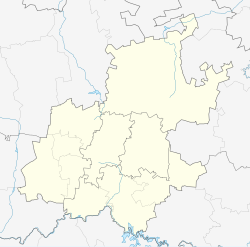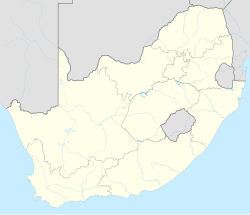Blairgowrie, Gauteng
Blairgowrie | |
|---|---|
| Coordinates: 26°06′59″S 28°00′34″E / 26.11639°S 28.00944°E / -26.11639; 28.00944 | |
| Country | South Africa |
| Province | Gauteng |
| Municipality | City of Johannesburg |
| Main Place | Randburg |
| Established | 1928 |
| Area | |
| • Total | 4.19 km2 (1.62 sq mi) |
| Population (2011)[1] | |
| • Total | 12,049 |
| • Density | 2,900/km2 (7,400/sq mi) |
| Racial makeup (2011) | |
| • Black African | 24.5% |
| • Coloured | 3.1% |
| • Indian/Asian | 9.1% |
| • White | 61.6% |
| • Other | 1.7% |
| First languages (2011) | |
| • English | 71.0% |
| • Afrikaans | 9.5% |
| • Zulu | 4.3% |
| • Tswana | 2.9% |
| • Other | 12.3% |
| Time zone | UTC+2 (SAST) |
| Postal code (street) | 2194 |
Blairgowrie is a suburb of Johannesburg, South Africa. It is located in Region B of the City of Johannesburg Metropolitan Municipality South Africa. It is named after the town of Blairgowrie in Scotland.
The suburb has an active community association called the Blairgowrie Community Association.[2]
History
[edit]Prior to the discovery of gold on the Witwatersrand in 1886, the future suburb lay on land on one of the original farms that make up Johannesburg, called Klipfontein.[3]: 70 The farm was bought by William Grey Rattray in 1890 and renamed it Craighall.[3]: 70 In 1928, his daughter would rename part of the land on the farm after her father, Rattray's birthplace, Blairgowrie in Scotland in Britain.[3]: 70 The suburb consisted of 406 stands over 56 ha and was established in 1941.[3]: 70
References
[edit]- ^ a b c d "Sub Place Blairgowrie". Census 2011.
- ^ "Blairgowrie Community Association". Archived from the original on 14 April 2012. Retrieved 3 July 2020.
- ^ a b c d Musiker, Naomi; Musiker, Reuben (2000). A Concise Historical Dictionary of Greater Johannesburg. Cape Town: Francolin. ISBN 1868590712.

